Recent Mold Remediation Posts
Mold Awareness and Prevention: What You Need to Know
12/19/2024 (Permalink)
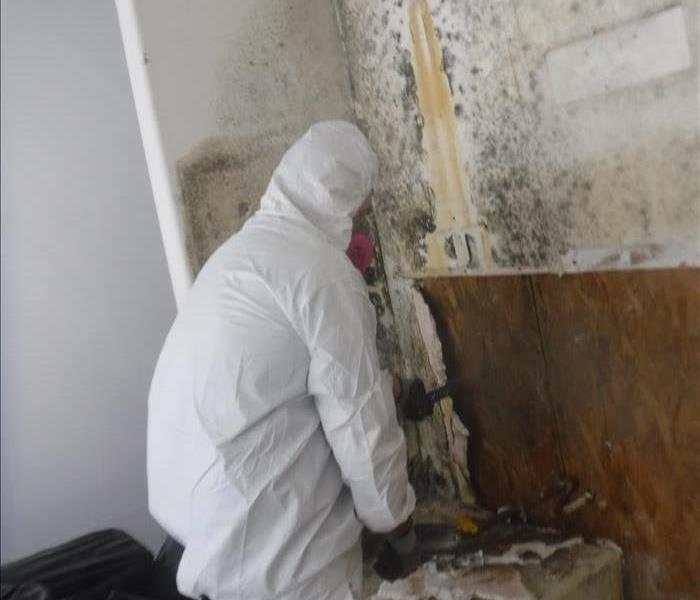 Protecting the space, one step at a time
Protecting the space, one step at a time
Mold is a common issue in properties, but it can pose serious health risks if not handled properly. If you spot visible mold in your home or business, it’s crucial to act with caution. Disturbing the mold can cause it to spread, worsening the problem and potentially leading to health complications. That’s where SERVPRO comes in—we are Here to Help® with professional mold remediation services, ensuring your safety and peace of mind.
How to Identify Mold: Key Signs to Watch For
Recognizing mold early can help prevent further damage and health issues. Here are some signs that mold may be present in your property:
- Musty Odors: The first indication of mold is often the unmistakable smell of mustiness. If you detect this odor, it could be a sign of mold growth.
- Visual Signs: Look for any discolored spots on walls, ceilings, or floors, especially water stains or warping. Mold growth can appear as patches of various colors, such as black, dark green, brown, purple, white, yellow, or even pink.
- Slimy Texture: Most mold types are dark and slimy, but molds can appear in various textures depending on the strain and growth stage.
What NOT to Do When You Spot Mold
If you see mold, it’s important to avoid certain actions that can make the situation worse. Here’s a list of things you should never do:
- Don’t Touch or Disturb It: Mold spores can easily become airborne when disturbed, spreading to other areas of your property.
- Don’t Clean It with Bleach or Disinfectants: While bleach may seem like a quick fix, it’s not effective at fully removing mold and can be harmful if used incorrectly.
- Don’t Paint Over Mold: Painting over mold is a temporary cover-up that doesn’t solve the underlying problem and may make the issue worse.
- Don’t Ignore It: Mold is a serious issue that can lead to structural damage and health risks. Don’t leave it unaddressed.
What to Do If You Find Mold
If you find mold in your property, follow these steps to help limit damage and ensure proper remediation:
- Stay Away from the Contaminated Area: Mold can pose health risks, so keep your distance until professionals arrive.
- Turn Off HVAC Systems and Fans: Mold spores can travel through air systems, so it’s important to shut them down to prevent further spread.
- Contact SERVPRO of Central Glendale: Our team specializes in mold remediation and is equipped with the right tools and expertise to safely remove mold and restore your property. Call us for immediate assistance.
Why Mold Grows and How SERVPRO Can Help
Mold thrives in environments with excess moisture. It needs water, oxygen, and a temperature range of 40 to 100°F to grow and spread. Whether it's caused by a leak, flooding, or humidity, mold can appear anywhere in your property—whether in hidden spaces like attics or basements or in more visible areas.
At SERVPRO, we use advanced equipment and containment techniques to prevent mold from spreading during remediation. Our trained professionals wear special protective gear and take care to isolate the affected area, ensuring mold doesn’t spread to other parts of your property.
Stay Safe with SERVPRO of Central Glendale
If you find mold, don’t hesitate to contact SERVPRO of Central Glendale. We are here to help you restore your property and safeguard your health. With our experience, knowledge, and specialized equipment, we can tackle the issue effectively. Remember—don’t disturb the mold and give us a call for expert mold remediation.
Contact SERVPRO of Central Glendale Today!
Why You Should Use a Mold Remediation Company
10/19/2022 (Permalink)
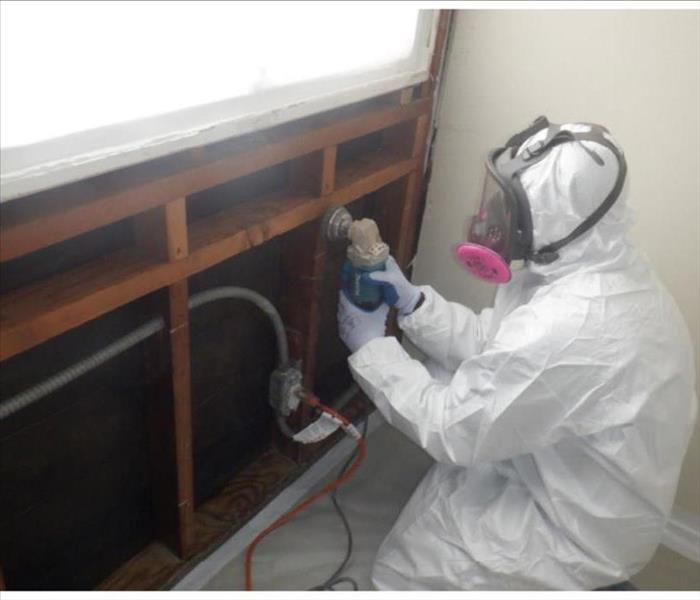 Mold can quickly grow in many houses, especially in the hidden dark, and damp areas.
Mold can quickly grow in many houses, especially in the hidden dark, and damp areas.
Mold damages your health, and your property and causes horrible effects. It is essential to know how to recognize mold signs to take fast action and prevent more severe damage.
Below are all signs and reasons why mold remediation is essential. Keep in mind that you need a mold removal specialist, a professional to take care of your mold inspection. It is necessary to remove all the damages professionally.
Reasons Why You Need a Mold Removal
To know the importance of taking care of your mold remediation as soon as possible, you need to understand the reasons why.
1. Mold Can Damage Your House in No Time
Mold will quickly devastate your place and properties before you notice. To prevent damage soon, hire a professional restoration company.
2. Mold Damage Can Be Unhealthy
If you leave mold untreated, it can have adverse effects like allergy symptoms, headaches, sinus congestion, fatigue, and weakness. Mold can be harmful to people with asthma, as well as your pets.
3. Structural Damage
There are various species of mold that exist and can usually be found in the invisible parts of a building. And if you leave mold untreated, it causes structural damage to your house so that nothing will be left.
Important Signs That Show You Need Mold Remediation
As mold damage may be hard to notice, homeowners should regularly inspect for mold growth in dark and wet areas. Meanwhile, if you notice these signs, you should immediately contact mold remediation experts.
1. Water Damage
As you may know, mold grows in humid areas. Whenever there is a water leak, there are more possibilities for mold damage.
For water damage cleanup, experts inspect to find how they can solve it as soon as possible. Calamities, broken plumbing systems and pipes, defective household appliances, bulk water, and many more reasons cause water damage.
2. Mold Smell & Odor
Some molds have a strong and musty smell. So, you need to notice any strange smells, especially if you have not been at your house for a while. Although you may not see the spot, a horrible smell is a great way to figure out mold infestations.
3. Condensation
Condensation can happen on walls, windows, and air ducts. This type of moisture causes mold growth, mainly if it occurs regularly. To prevent such a bad condition, consider using a good humidifier to regulate your home temperature appropriately.
4. Dark Spots
If you are moving into a new place, be sure to check every wall for any dark spots, especially in the basement or the bathrooms. Mold growth that has been left unchecked for a long time can result in discoloration. But molds are not always black; they may appear white and gray-brown, pink, or grayish-green. As a result, if you notice such spots on the walls, it could be a sign that something is wrong. In this case, you should contact SERVPRO® of Central Glendale today at 818-246-2200.
Do This Before You Purchase a Home
8/18/2022 (Permalink)
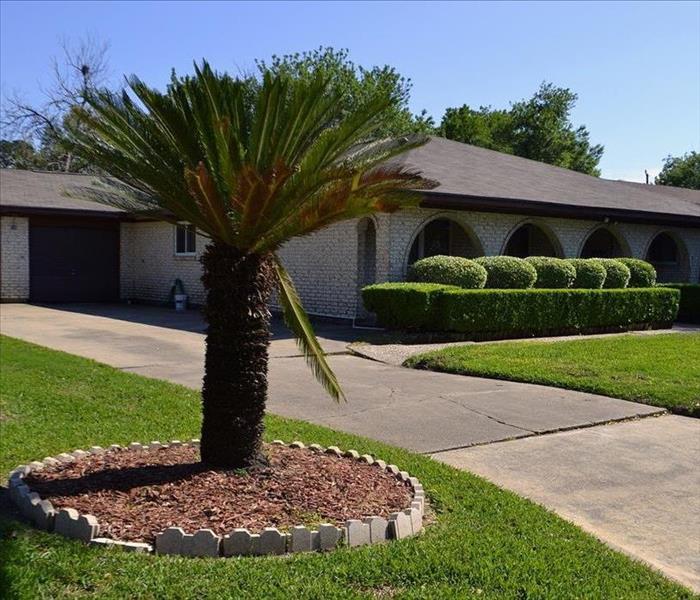 Before you purchase a home, inspect the property for mold.
Before you purchase a home, inspect the property for mold.
Mold is Everywhere
Mold spores exist everywhere, whether you are indoors or outdoors. What does that mean? It means unfortunately, it is easy for it to grow and become a problem wherever moisture is present.
It is crucial to be able to identify mold growth before purchasing a home. It is a huge life accomplishment, so you need to be careful and take precautions. Follow these four tips that will help you identify possible mold risks in a new home.
Tip 1: Look for musky odors
At times, mold can be hidden from view. Fortunately, your sense of smell can help point you in the right direction. If you notice a musty or mildewy smell in the home, this may indicate there is mold growth. This is very true when the smell is stronger in certain areas and rooms of the property.
Mold has a strong, distinct odor. The scent can also be described as earthy, stale and wet. Use your nose as the first sign that there may be mold in the home.
Tip 2: Look Around
While touring a home, it is important to keep an eye out for potential mold growth. The green and black stuff tends to accumulate in dark, moist areas. Be sure to look in these areas. Common places you should always check include:
- Beneath counters and under sinks
- Bathtub grout
- Crawlspaces, attics and basements
- Inside toilets
- Windowsills
There are other visual indicators of possible mold, even if you don’t see the mold itself. It is possible for it to grow on the other side of the wall. Look out for water stains on walls and ceilings. Look for leaking pipes and faucets too.
Tip 3: Ask Questions
Be sure to ask the current homeowners about past water damage and flooding. You may also want to investigate whether the home is in a flood zone. If there has been water damage in the past, pay extra attention to whether there is mold currently present in the home. Be sure to inquire about how they remediated past water damage. Also ask as if water damage has been reoccurring or not. This can be a sign of future water and mold problems.
Tip 4: Have the Home Inspected
Home inspectors are trained to spot water damage and signs of mold in a home. Look to see if any signs of mold were noted in the inspection report. Also see if they provide any kind of mold guarantee.
If you happen to find mold after you already purchased the home, give SERVPRO® of Central Glendale a call. We can start the mold remediation process immediately and fix any other water damage the structure may have. Give us a call today at 818-246-2200.
Why Mold Must Never Be Disturbed
6/9/2022 (Permalink)
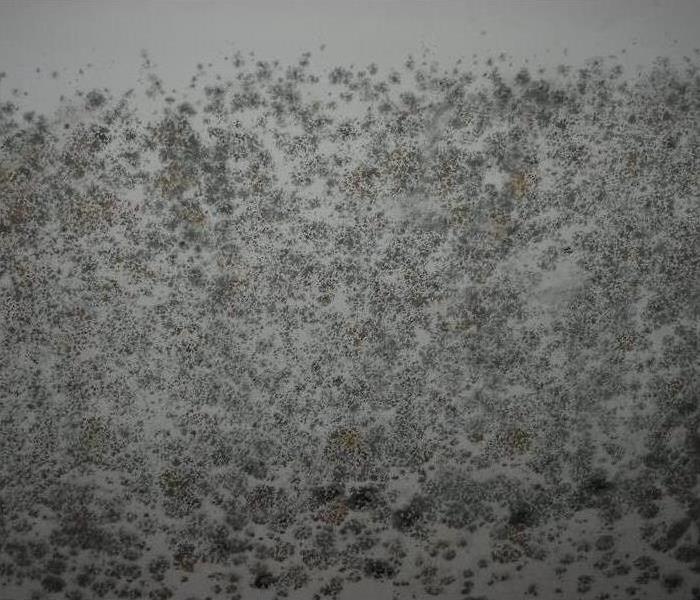 Mold grows on non-porous surfaces including walls.
Mold grows on non-porous surfaces including walls.
Eliminating mold from large areas of the home or office requires expertise and protection and should never be touched.
What is Mold?
Mold is a type of fungus that thrives in moist, dark environments. It can grow on a variety of non-porous surfaces, including wood, paper, and carpet. Mold is often found in homes, schools, and businesses. While small amounts of mold are not harmful, large amounts can be. Disturbing mold can release spores into the air which is never good.
It is commonly found in homes and businesses that have suffered water damage or have high humidity levels. Mold can damage the structure of a building and negatively impact the quality of life for residents.
For this reason, it is crucial that mold growth is removed by trained professionals.
Damp Areas Not Only Grow Mold
Although mold and its spores are literally everywhere, active mold growth requires moisture. Whether on visible surfaces or hiding behind drywall, in attics, or under carpets, indoor mold grows in the presence of excessive dampness or water. Also found in damp indoor environments are:
- dust mites
- bacteria
- airborne chemicals, gasses, and particulate matter caused by the destruction of materials.
- Microorganisms and molds break down organic compounds into products, including proteins, cell-wall fragments (glucans), and volatile organic chemicals (the actual source of the musty odor associated with mold)
If you suspect there is mold in your home or business, it is important to call a professional mold removal company like SERVPRO of Central Glendale. Our trained technicians will safely and effectively remove the mold from your property.
Mold removal from large areas (such as entire houses or offices) requires both skill and safety. This is for the experts as well as people who live in the affected area. Give SERVPRO of Glendale a call at 818-246-2200 and we will schedule our mold remediation team to remove it fast.
How SERVPRO of Central Glendale Handled This Mold Problem
2/9/2022 (Permalink)
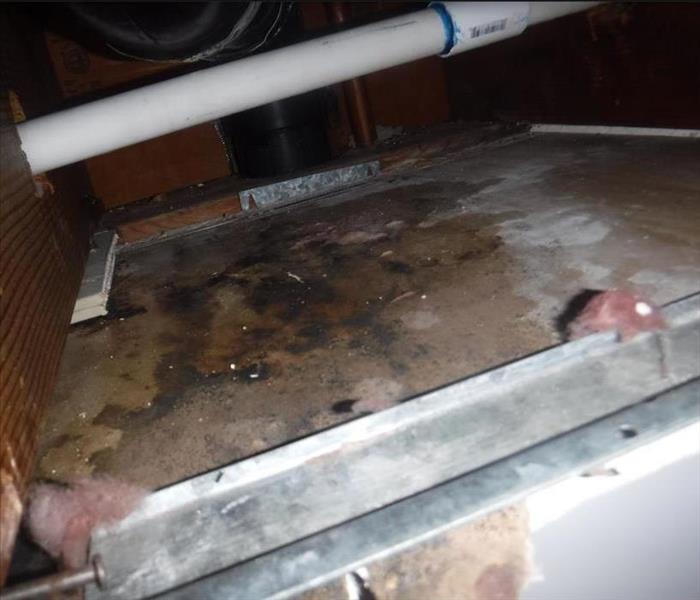 Mold can grow in moist places like under the sink. That's what happened here in this Glendale home.
Mold can grow in moist places like under the sink. That's what happened here in this Glendale home.
Mold can grow anywhere and everywhere!
Dark, moist places like under the sink, in the back of a closet, and even where the water heater is can all be perfect homes for mold and mildew to grow colonies. That is exactly what happened to a local Glendale homeowner when she began to smell something foul under the sink. She cleared the space for a better look, and that's when she noticed a small leak coming from a pipe. Water from the leak had seeped down and caused mold to grow at the bottom and along the walls.
When SERVPRO of Central Glendale's mold remediation technicians arrived at their scheduled appointment, the project manager investigated the mold growth under the sink. He advised the homeowner to first call a plumber to fix the leak. The project manager explained that the mold problem would continue if there was still moisture, even if the mold remediation crew removed what was already growing.
After a plumber was called in and the leak under the sink was fixed, our mold remediation techs got to work immediately. Since the mold did not grow beyond the small area, it was easier to remove it. Our SERVPRO of Central Glendale mold remediation experts began to build a small containment around the kitchen sink, guaranteeing that any mold spores would not escape the area. From there, they begin to cut through the moldy wood. Equipped in head-to-toe PPE suits, they professionally removed all affected areas, leaving no trace of mold behind.
During the mold removal process, the technicians ran our air filtration equipment that cleaned the air within the surrounding area. They knew cleaning the air assured all mold spores would be eliminated. It also helped get rid of the unpleasant smell taking over the kitchen. After the mold remediation process was complete, the grateful homeowner thanked us for helping her get rid of a big problem. We were happy to help!
If you are experiencing a mold problem, please call SERVPRO of Central Glendale's office at 818-246-2200 to schedule an inspection. Remember, mold is not something you want to handle yourself. Call our mold removal experts and see what we can do for you today.
Reduce Your Risk of Mold By Repairing Leaky Appliances
11/21/2018 (Permalink)
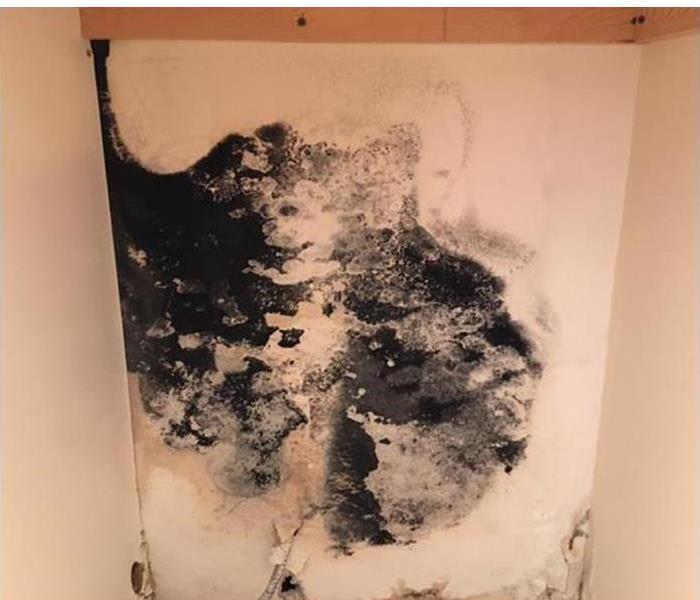 Leaky Appliances Can Cause MOLD!
Leaky Appliances Can Cause MOLD!
Leaky appliances in your home can lead to extensive water damage and even mold growth if not taken care of quickly. If the conditions are right, it only takes 24-48 hours for mold to start growing. By keeping an eye on your appliances, you can help catch leaks early and reduce the risk of mold growth.
Follow these tips to help reduce the risk of leaky appliances and pipes in your home and reduce your risk of mold growth.
- Regularly check your washing machine, dishwasher, refrigerator, water heater, sinks and toilets for signs of leaks.
- Routinely check for leaky pipes, appliance hoses and faucets.
- If you see signs of leaks, such as condensation or water collecting anywhere, dry it quickly and find the source of the leak and fix it.
- Fix plumbing problems immediately.
- Monitor your utility bills each month. An unusually high water bill can be a sign of an unseen leak.
By keeping an eye out for leaks from appliances and other water sources in your home, you can catch leaks early and reduce the risk of water damage and mold growth. If you do encounter mold growth or other water damage, give us a call at (818) 246-2200. SERVPRO of Central Glendale can make it “Like it never even happened.”
Tips for Spotting Mold in a Potential Home Buy
11/21/2018 (Permalink)
 Have Your Home Inspected
Have Your Home Inspected
Mold spores can exist just about anywhere inside or out. Unfortunately, that means it’s easy to develop a mold growth problem wherever moisture and a food source are present.
It’s important to be able to identify potential mold growth before buying a new home. Follow these four tips to help identify possible mold risks in a new home.
Tip 1: Use Your Nose
Of course, some mold is hidden from view. Fortunately, your sense of smell can help point you in the right direction. If you notice a strange odor in the home, particularly if the smell is stronger in certain areas of the home, this may indicate there is mold.
Mold has a musty, distinct odor. The smell could also be described as stale, wet, and earthy. Use your nose as the first sign that there may be mold in the home.
Tip 2: Look Around
While touring a potential home buy, it’s important to keep an eye out for potential mold growth. Mold tends to accumulate in moist, dark areas, so be sure to take a look in these areas. Common places you should check include:
- Window sills
- Beneath counters and under sinks
- Bathtub grout
- Inside toilets
- Attics and crawlspaces
There are other visual indicators of possible mold, even if you don’t see the mold itself. Look out for water stains on ceilings or walls. Look for leaking pipes and faucets as well.
Tip 3: Ask Questions
Be sure to ask the current homeowners about past water damage and flooding. Also look into whether the home is in a flood zone. If there has been water damage in the past, pay extra attention to whether there is mold currently present in the home. Also inquire about how they remediated past water damage. Also ask as if water damage has been reoccurring or not. This can be a sign of future water and mold problems.
Tip 4: Have the Home Inspected
Home inspectors are trained to spot water damage and signs of mold in a home. Look to see if any signs of mold were noted in the inspection report. Also see if they provide any kind of mold guarantee.
If after buying a new home you find mold, give SERVPRO of Central Glendale a call. We can start the mold remediation process immediately and fix any other water damage the structure may have. Give us a call today at 818-246-2200.
Pomona tenants allege cockroach infestation, pervasive mold growth in lawsuit
11/20/2018 (Permalink)
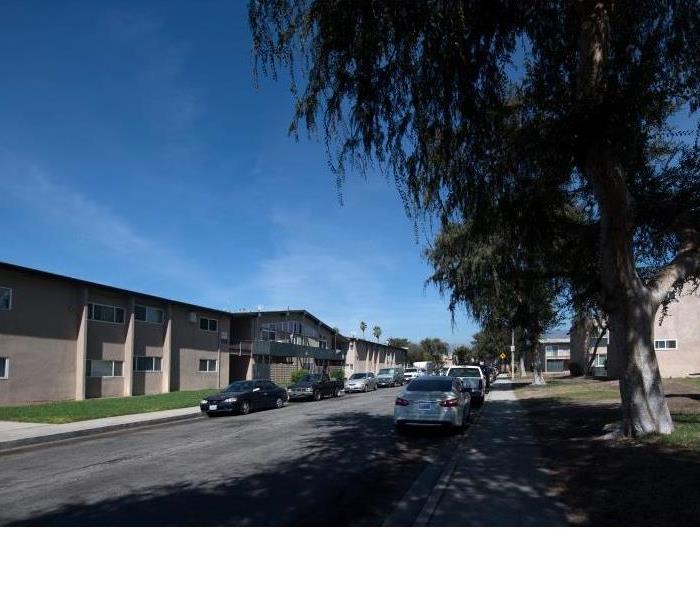 Mold Grows in Pomona, CA Apartment
Mold Grows in Pomona, CA Apartment
Current and former tenants in three Pomona apartments have filed a lawsuit, alleging their units were crawling in cockroaches that were getting into their clothes, had to be picked off their kids’ bodies and were even found in their hair. The conditions were so deplorable, residents had to regularly toss food because of the feces and filth the roaches left behind.
Thursday’s filing by 16 current and former tenants of Casa Grande and Pomona Grove Apartments allege the absentee landlord allowed inhumane conditions to occur as far back as 2014. That includes exposure to bedbugs, incidents of raw sewage seeping into a common area and faulty utilities, according to the suit.
Mold growth was so pervasive, it would return despite numerous attempts to clean the flooring and walls in units, they allege.
The 39-page filing from Santa Monica-based law firm Cypress LLP paints a picture of a landlord who not only failed to take corrective measures but allowed his onsite management to threaten tenants when they complained about the conditions.
“Defendants know that they can prey on vulnerable, low-income tenants in an area suffering a severe affordable housing shortage,” the claim states. “If tenants exercise their rights or speak up, defendants threaten them with eviction, which for many plaintiffs means homelessness.”
The suit claims William C. Chu, who has owned the complexes — Casa Grande at 700 N. East End Ave. and Pomona Grove Apartments at 707 N. East End Ave. since 2011 — was not only negligent but committed fraud by requiring the tenants to pay for shoddy cleanup and maintenance work, never deducting it from their rent or compensating them for costs incurred. The occupants also claim the uninhabitable living conditions caused them emotional distress.
Neither Chu nor the property manager responded to requests for an interview. A representative from Chu’s office was not aware of the lawsuit and asked for details. The lawsuit notes that Chu “resides comfortably” in a $4.5 million home in San Marino.
“Mold Removal” vs. Remediation
11/20/2018 (Permalink)
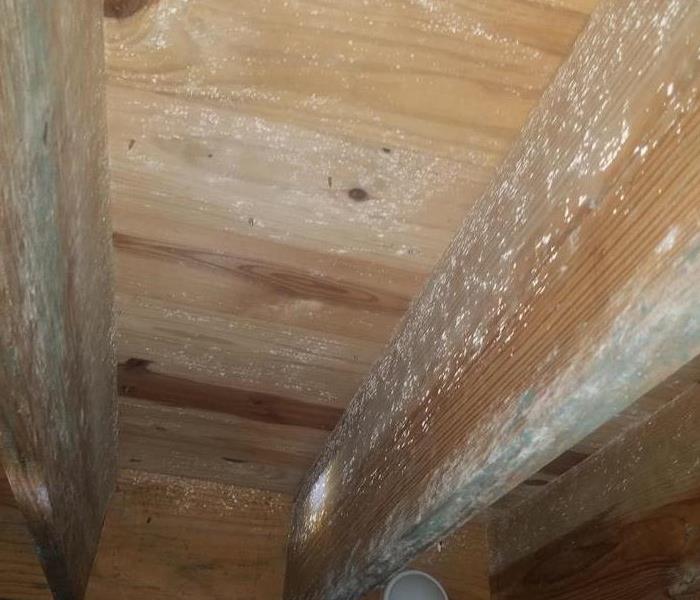 Mold in Attic
Mold in Attic
Since microscopic mold spores exist naturally almost everywhere, indoors and outdoors, removing all mold from a home or business is impossible. Some restoration businesses advertise “mold removal” and even guarantee to remove all mold. This is a fallacy.
A qualified restoration company understands the science behind mold and mold growth. SERVPRO Franchise Professionals have the training and expertise to remediate the mold in your home or business. Mold remediation focuses on getting mold levels back to normal, natural levels.
Every mold damage scenario is different and requires a unique solution, but the general mold remediation process stays the same. To learn more about our mold remediation process.
- Step 1: Emergency Contact 1-800-SERVPRO
- Step 2: Inspection and Mold Damage Assessment
- Step 3: Mold Containment
- Step 4: Air Filtration
- Step 5: Removing Mold and Mold-Infested Materials
- Step 6: Cleaning Contents and Belongings
- Step 7: Restoration
Understanding Mold
When water intrudes into your property, mold growth can start in as little as 48 hours. Consider the following mold facts:
- Mold is present almost everywhere, indoors and outdoors.
- Mold spores are microscopic, float along in the air, and may enter your home through windows, doors, or AC/heating systems or even hitch a ride indoors on your clothing or a pet.
- Mold spores thrive on moisture. Mold spores can quickly grow into colonies when exposed to water. These colonies may produce allergens and irritants and have the potential to cause other health effects.
- Before mold remediation can begin, any sources of water or moisture must be addressed. Otherwise, the mold may return.
- Mold often produces a strong, musty odor, and that odor can lead you to possible mold problem areas.
- Even higher-than-normal indoor humidity can support mold growth. Keep indoor humidity below 45 percent.
Does your home have a Mold Problem?
1/11/2018 (Permalink)
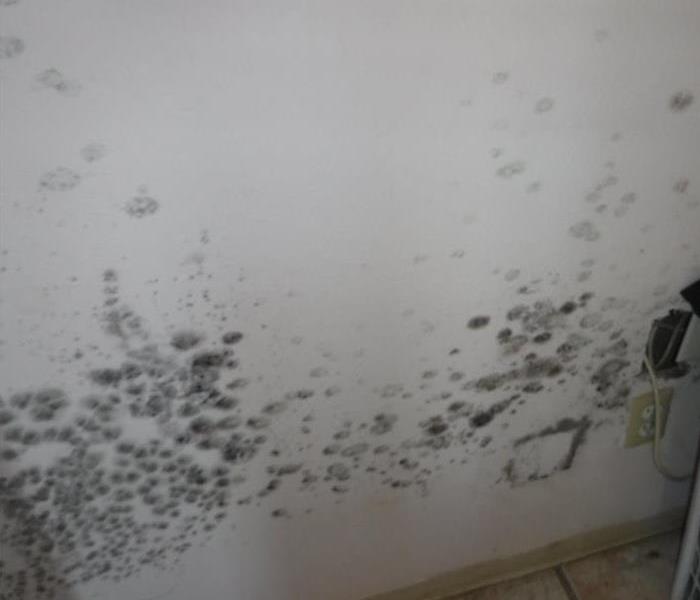 Mold located on the walls of a Glendale home.
Mold located on the walls of a Glendale home.
Microscopic mold spores naturally occur almost everywhere, both outdoors and indoors. This makes it impossible to remove all mold from a home or business. Therefore, mold remediation reduces the mold spore count back to its natural or baseline level. Some restoration businesses advertise “mold removal” and even guarantee to remove all mold, which is a fallacy. Consider the following mold facts:
Mold is present almost everywhere, indoors and outdoors.
Mold spores are microscopic and float along in the air and may enter your home through windows, doors, or AC/heating systems or even hitch a ride indoors on your clothing or a pet.
Mold spores thrive on moisture. Mold spores can quickly grow into colonies when exposed to water. These colonies may produce allergens and irritants.
Before mold remediation can begin, any sources of water or moisture must be addressed. Otherwise, the mold may return.
Mold often produces a strong, musty odor and can lead you to possible mold problem areas.
Even higher-than-normal indoor humidity can support mold growth. Keep indoor humidity below 45 percent.
If your home or business has a mold problem, we can inspect and assess your property and use our specialized training, equipment, and expertise to remediate your mold infestation.
If You See Signs of Mold, Call Us Today – (818) 246-2200
Mold Problems
1/11/2018 (Permalink)
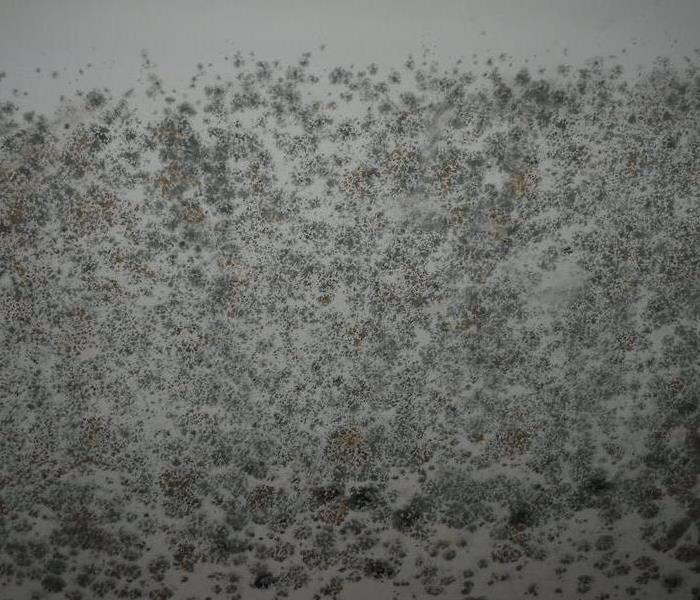 Be careful! Mold can be very dangerous.
Be careful! Mold can be very dangerous.
If you see visible mold, do not disturb it. You can inadvertently spread the mold infestation throughout your home. When mold is disturbed, the mold can release microscopic mold spores which become airborne and can circulate inside your home.
What to Do:
Stay out of affected areas.
Turn off the HVAC system and fans.
Contact SERVPRO of Central Glendale for mold remediation services.
What Not to Do:
Don’t touch or disturb the mold.
Don’t blow air across any surfaces with visible or suspected mold growth.
Don’t attempt to dry the area yourself.
Don’t spray bleach or other disinfectants on the mold.
About Our Mold Remediation Services
SERVPRO of Central Glendale specializes in mold cleanup and restoration, in fact, it’s a cornerstone of our business. Our crews are highly trained restoration professionals that use specialized equipment and techniques to properly remediate your mold problem quickly and safely.
If You See Signs of Mold, Call Us Today – (818) 246-2200
Mold 101
10/13/2017 (Permalink)
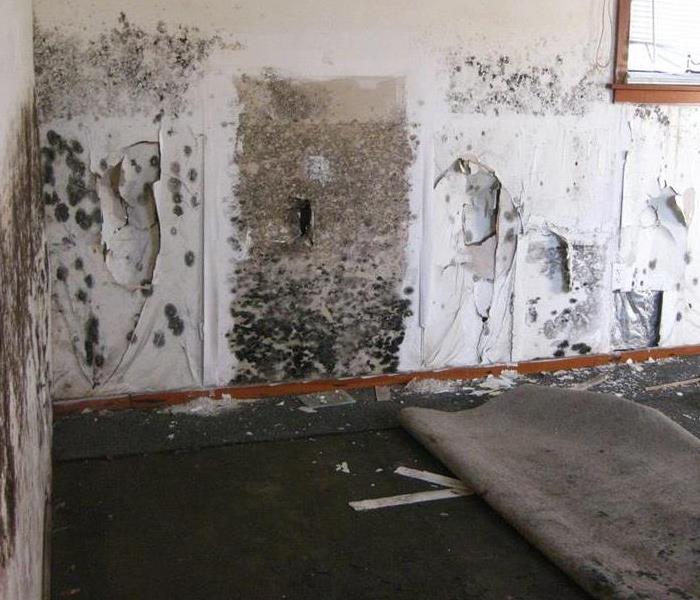 Molds and other fungi grow easily in damp indoor environments. People who spend time in such environments sometimes complain of respiratory effects.
Molds and other fungi grow easily in damp indoor environments. People who spend time in such environments sometimes complain of respiratory effects.
Mold is a non-scientific term for many types of fungi - unwanted, unappealing patches of black, brown, yellow, pink, green, smelly, fuzzy growths. Countless species of mold are found both indoors and outdoors.
"Mold" and "fungus" have many connotations, most of them unpleasant: musty odors, damp basements, moldy carpets, water leaks, soggy drywall, athlete's foot, and poisonous mushrooms, among others. On the positive side, molds are also responsible for penicillin and blue cheese; yeasts are fungi (plural of fungus) used to make bread, beer, and wine; and some types of mushrooms are considered edible delicacies. And without fungi to break them down, the world would be buried in leaves, trees, grass, and garbage.
Although mold and its spores are literally everywhere, active mold growth requires moisture. Whether on visible surfaces or hiding behind drywall, in attics, or under carpets, indoor mold grows in the presence of excessive dampness or water. Also found in damp indoor environments are:
- bacteria;
- dust mites;
- break-down products of bacteria and molds, such as proteins, cell-wall particles (glucans) and volatile organic compounds (the actual cause of the musty odor associated with mold);
- airborne chemicals, gasses, and particulate matter caused by destruction of materials by growing molds.
Indoor mold may be unsightly and smelly, but the potential problems are more serious than that. By definition, actively-growing mold damages the material it lives on, thereby impairing structural integrity. In addition, mold is associated with some untoward health effects in humans, including allergies and infections. (Some health effects attributed to mold may in fact be caused by bacteria, dust mites, etc., found in mold-colonized environments. So-called "toxic mold" has been claimed as the cause of "toxic mold disease"; this syndrome remains undefined and "toxic mold" as a cause remains unproven. "Toxic mold" is also unproven as a cause of the various symptoms associated with "sick building syndrome".
Mold growth in homes, schools, and businesses should be eliminated for the sake of human health, structural integrity, and quality of life. Cleaning up small amounts of mold can be done by homeowners. Eliminating mold from large areas requires expertise and protection both for the removal specialists and occupants of the affected space.
How Mold Effects Human Health
10/13/2017 (Permalink)
 Spending time in damp and moldy buildings seems to increase the risk of bronchitis and respiratory infections, but is not proven to do so.
Spending time in damp and moldy buildings seems to increase the risk of bronchitis and respiratory infections, but is not proven to do so.
Molds and other fungi grow easily in damp indoor environments. People who spend time in such environments sometimes complain of respiratory effects, headaches, and other physical symptoms. In addition to visible or hidden mold, damp spaces likely harbor mold break-down products, dust mites, bacteria, and chemicals, gasses, and particulate matter released from the materials on which molds are growing. Given the difficulties in testing for all of these elements, hard evidence of precise cause-and-effect can be elusive.
In an extensive 2004 report, the Institute of Medicine (IOM) did not find enough evidence to identify health effects which were definitely caused by spending time in damp indoor spaces. However, the experts found that being in damp indoor spaces seemed related to respiratory illnesses: nose and throat [upper respiratory] symptoms, cough, wheeze, and asthma symptoms. They also found limited evidence that these environments can be associated with shortness of breath, the development of asthma in people who did not previously suffer from it, and lower respiratory symptoms (coughing, wheezing, chest tightness, and shortness of breath) in healthy children. Based on available research, IOM was not able to substantiate claims of numerous other symptoms such as skin irritations, fatigue, cancer, lung disease, or respiratory infections. There was enough evidence of health effects overall, though, that IOM identified damp indoor spaces as a public health problem that needs to be addressed.
It can be difficult or impossible to assess all types of molds, spores, fungal fragments, chemicals from destruction of mold-colonized materials and second-hand smoke, and other airborne matter indoors at any given time. Though numerous studies associate the presence of dampness and mold with respiratory allergies and asthma, it can be equally difficult or impossible to establish the presence of these substances as the definitive cause of illness in particular patients.
Are You Sick of The Mold In Your Home?
8/24/2017 (Permalink)
Mold and Your Home
Mold is found both indoors and outdoors. Mold can enter your home through open doorways, windows, vents, and heating and air conditioning systems. Mold in the air outside can also attach itself to clothing, shoes, bags, and pets can and be carried indoors.
Mold will grow in places with a lot of moisture, such as around leaks in roofs, windows, or pipes, or where there has been flooding. Mold grows well on paper products, cardboard, ceiling tiles, and wood products. Mold can also grow in dust, paints, wallpaper, insulation, drywall, carpet, fabric, and upholstery.
You Can Control Mold
Inside your home you can control mold growth by:
- Controlling humidity levels;
- Promptly fixing leaky roofs, windows, and pipes;
- Thoroughly cleaning and drying after flooding;
- Ventilating shower, laundry, and cooking areas.
If mold is growing in your home, you need to clean up the mold and fix the moisture problem. Mold growth can be removed from hard surfaces with commercial products, soap and water, or a bleach solution of no more than 1 cup of household laundry bleach in 1 gallon of water.
Mold growth, which often looks like spots, can be many different colors, and can smell musty. If you can see or smell mold, a health risk may be present. You do not need to know the type of mold growing in your home, and CDC does not recommend or perform routine sampling for molds. No matter what type of mold is present, you should remove it. Since the effect of mold on people can vary greatly, either because of the amount or type of mold, you can not rely on sampling and culturing to know your health risk. Also, good sampling for mold can be expensive, and standards for judging what is and what is not an acceptable quantity of mold have not been set. The best practice is to remove the mold and work to prevent future growth.
If you choose to use bleach to clean up mold:
- Never mix bleach with ammonia or other household cleaners. Mixing bleach with ammonia or other cleaning products will produce dangerous, toxic fumes.
- Open windows and doors to provide fresh air.
- Wear non-porous gloves and protective eye wear.
- If the area to be cleaned is more than 10 square feet, consult the U.S. Environmental Protection Agency (EPA) guide titled Mold Remediation in Schools and Commercial Buildings. Although focused on schools and commercial buildings, this document also applies to other building types. You can get it by going to the EPA web site.
- Always follow the manufacturer’s instructions when using bleach or any other cleaning product.
Mold Prevention
8/24/2017 (Permalink)
MOLD PREVENTION TIPS
- Keep humidity levels as low as you can—no higher than 50%--all day long. An air conditioner or dehumidifier will help you keep the level low. Bear in mind that humidity levels change over the course of a day with changes in the moisture in the air and the air temperature, so you will need to check the humidity levels more than once a day.
- Be sure your home has enough ventilation. Use exhaust fans which vent outside your home in the kitchen and bathroom. Make sure your clothes dryer vents outside your home.
- Fix any leaks in your home’s roof, walls, or plumbing so mold does not have moisture to grow.
- Clean up and dry out your home thoroughly and quickly (within 24–48 hours) after flooding.
- Add mold inhibitors to paints before painting.
- Clean bathrooms with mold-killing products.
- Remove or replace carpets and upholstery that have been soaked and cannot be dried promptly. Consider not using carpet in rooms or areas like bathrooms or basements that may have a lot of moisture.
- To learn more about preventing mold in your home, see the Environmental Protection Agency's publication A Brief Guide to Mold, Moisture, and Your Home at http://www.epa.gov/mold/moldguide.html.






 24/7 Emergency Service
24/7 Emergency Service







